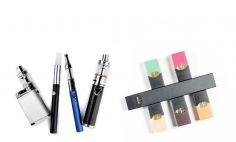Vapes. E-cigarettes. E-hookahs. Mods. Vaporizer devices all have the same purpose: to heat liquids containing nicotine or marijuana that people can inhale or puff.
Vapes and e-liquids have often been touted as fun, fruit-flavored, and safe. But research shows a much different picture. One out of four high school seniors reported past-month nicotine use, according to a recent survey funded by the National Institute on Drug Abuse (NIDA). Also concerning is the near doubling of high school seniors reporting past-month marijuana vaping, from 7.5% in 2018 to 14% in 2019.
To address the increase in youth vaping, NIDA is leading the charge toward prevention efforts, understanding why youth vape and how vaping nicotine or marijuana may lead to addiction. NIDA is also supporting studies aimed at uncovering the long-term health effects of e-cigarettes in both teens and adults; the types of vape devices people use; and the health impact of the various components used with vapes, including nicotine, marijuana, flavoring, and other chemicals.
Researchers are also studying the impact of advertising, social media, and peer pressure on teenagers. The results so far are concerning. Vaping devices are now the most common way for youth in the U.S. to use nicotine.
"The vaping studies have worried us enormously," says NIDA Director Nora Volkow, M.D. "While teen smoking rates remain at historically low levels, more teenagers are embracing vaping and are being exposed to drugs that otherwise they may not have taken."
Targeting teens
TV and social media ads target teens with the appealing flavors and brightly colored packaging of vapes. For instance, vapes come in colors that match the fruity flavors they contain, such as blue for blueberry and green for mint.
"Some teens don't even know that e-cigs contain nicotine."
- Lucy Popova, Ph.D.
And, on some social media channels, teens can see peers and others, like social influencers and celebrities, vaping.
"There's a lot of social influencing going on," says Lucy Popova, Ph.D., assistant professor at the School of Public Health at Georgia State University. "Much of it is the perception that the cool kids are using e-cigs."
Dr. Popova is conducting National Institutes of Health-funded research that identifies worrisome trends seen in popular YouTube vaping videos, like how to modify or "hack" a pre-packaged vape to include other substances or more marijuana or nicotine. She's also researching the influence of advertising and e-cigarette prevention messages on teens and adults, including warning labels.
Dr. Popova says that many teens, like adults, think e-cigarettes are better for their health than traditional cigarettes. That's in part because vape manufacturers don't always make it clear which chemicals or drugs are actually in their vapes.
"What's worrisome is that so many kids who would not normally use tobacco are using e-cigarettes," says Dr. Popova. "Some teens don't even know that e-cigs contain nicotine."
To help address this problem, a federal law that prevents people under the age of 21 from buying vapes and tobacco products went into effect in January 2020. Previously, the minimum age was 18 in some states and 21 in others.
Potential for long-term effects
Studies show that over 30% of teens who vape are more likely to start smoking cigarettes than teens who don't vape. In addition, twice as many boys use vapes than girls. And teens and their parents may not realize that vaping nicotine or marijuana can change the way the brain works and how it develops, now and in the future.
"Research has shown that teenagers who smoke marijuana are at much greater risk of becoming addicted to it," says Dr. Volkow. "And becoming addicted as a teen increases the risk of becoming addicted to other drugs as you get older." She says there’s evidence that marijuana use may impair memory, attention, and motivation; affect school performance; and lead some teens to drop out.
Changing social norms
Dr. Popova says that changing social norms will be key to reducing teen vaping.
"We need to equate e-cigarettes with cigarettes so that teens don't think e-cigs are more 'cool,'" Dr. Popova says. "Years ago, we had ashtrays everywhere, and then we saw a complete switch in social norms. I think we can do that with nicotine, whether it's inhaled using vapes or cigarettes."
Another important part of reducing teen vaping: keeping parents informed, so they can talk to their teens about the real impacts of vaping.
"We recommend that parents speak with their children and be very open about it to make their child feel comfortable," Dr. Volkow says. "Otherwise, if they feel their parents are angry at them and very judgmental about their behavior, they may shy away and become secretive."







